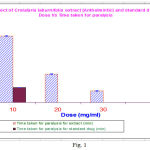K. Ravi Shankar¹, Chandralekha Gurjar² and B. A. Khatoon³
¹Aditya Institute of Pharmaceutical Sciences and Research-Surampalem.
²Sarada Vilas College of Pharmacy-Mysore
³Yuvaraja’s College-Mysore.
Abstract
In present work the methanolic extract of whole plant crotalaria Laburnifolia was evaluated for its antimicrobial activity employing the standard cup–plate method. The Anthelmintic activity was also studied on adult earth worms(Pheretima posthuma). The analgesic activity was performed on mice using tail-flick method. The extract showed significant activities and the results were compared with standard drugs.
Keywords
Crotalaria Laburnifolia ; antimicrobial ; anthelmintic ; analgesic effect
Download this article as:| Copy the following to cite this article: Shankar K. R , Gurjar C , Khatoon B. A. Pharmacological Investigations of Crotalaria Laburnifolia. Biomed Pharmacol J 2008;1(1). |
| Copy the following to cite this URL: Shankar K. R , Gurjar C , Khatoon B. A. Pharmacological Investigations of Crotalaria Laburnifolia. Biomed Pharmacol J 2008;1(1). Available from: http://biomedpharmajournal.org/?p=360 |
Introduction
The plant Crotalaria laburnifolia belonging to family Papilonaceae have been in use as a cure for snake and scorpion bites1,2. The seeds of this plant has been traditionally used as an anticancer agent. Much phytochemical work was carried and several alkaloids were isolated from Crotalaria species. Pyrrolizidine3,4 alkaloids were isolated from Crotalaria laburnifolia plant and the activities may be due to the presence of Pyrrolizidine alkaloids.
Experimental
Collection
The plant Crotalaria laburnifolia was collected in march-may 2007 from the campus of Bangalore University,Bangalore-India. The plant was authenticated by Prof.K.Gayathri Dept. of Botany Yuvaraja’s college University of Mysore. The whole plant was removed dried under shade and then powdered in a mechanical grinder. The coarse powder was extracted with methanol and the obtained extract was used for pharmacological work. All chemicals and reagents used for the study of pharmacological activities are of analytical grade.
Antimicrobial activity
The antimicrobial activity was studied employing standard cup-plate method. Microbes used were Bacillus subtilis, staphylococcus aureus, Pseudomonas aeuroginosa and Escherichia coli. The activity was compared with that of standard drugs streptomycin and gentamycin.
Table:1 Antimicrobial activity of Crotalaria laburnifolia extract Zone inhibition (mm)
| Extract
() |
Bacillus subtilis | Staphylococcus aureus | Pseudomonas aeuroginosa | Escherichia coli |
| 100 | 13 | 13 | 12 | -b |
| 150 | 14 | 15 | 14 | -b |
| 200 | 15 | 16 | 17 | -b |
| Ref.
(10 ) |
23
Streptomycin |
21
Streptomycin |
24
Gentamycin |
22 Gentamycin |
Results are mean s.d. values of 3 replicates
-b indicates no activity diameter of the inhibition zone is less than 10mm.
Anthelmintic activity
The anthelmintic activity was evaluated on adult earthworms(Pheretima posthuma) due to its anatomical and physiological resemblance with the intestinal roundworm parasites of human beings. The activity of methanolic extract of Crotalaria laburnifolia was compared with that of the effect produced by the standard drug Albendazole. The data is given in table 2 and fig. 1-2.
Table:2 Anthelmintic activity of Crotalaria laburnifolia extract
| Type of extract | Dose
(mg/ml) |
Time taken for Paralysis(min) | Time taken for death (min) |
| Methanolic | 10 | 103.2 0.96 | 146.4 0.28 |
| 20 | 44 0.40 | 62.4 0.72 | |
| 30 | 17.5 0.30 | 42.5 0.40 | |
| Albendazole | 10 | 23 0.20 | 52 0.42 |
| Vehicle
(D.Water) |
– | – | – |
 |
Figure 1 |
Analgesic effect
The study of analgesic effect in mice was performed and the commonly used procedure is tail-flick(tail with drawn from the radiant heat) method using analgesiometer. In this method heat is used as source of pain and the animals are weighed(15-20gm) and numbered the basal reaction time to radiant heat by placing the tip(last 1-2cm) of the tail on the radiant heat source. The tail with drawl from the heat(flicking response) is taken as the end point. Normally the mouse with drawl its tail within 2-4seconds. Analgesics increase the reaction time a cutoff period of 10 seconds is observed to prevent damage to the tail. At least 3-5 animals basal reaction time for each mouse at a gap of 5min. to conform normal behavior of the animal.
Table:3 Observations in mice (Tail flick method)
| S.No. | Basal reaction time
(sec) 1 2 3 4 5 |
Reaction time(sec)after
Crotalaria laburnifolia extract 15min 30min |
| 1. | 2 2 3 4 3 | 4 5 |
| 2. | 3 3 2 2 3 | 4 6 |
| 3. | 2 3 3 2 3 | 3 4 |
| 4. | 3 4 3 2 2 | 4 5 |
| 5. | 3 2 3 3 2 | 3 6 |
Crotalaria laburnifolia extract 10mg/Kg
Results and discussion
The methanolic extract of Crotalaria laburnifolia showed significant antimicrobial activity and is compared with standard antibiotic Streptomycin and Gentamycin (Table 1). The anthelmintic activity was studied and the extract at high concentration showed significant activity (Table 2, and Fig. 1-2) and this is compared with the effect produced by the standard drug Albendazole. The analgesic activity of the extract of Crotalaria laburnifolia on mice using tail flick method possessing mild analgesic activity.
References
- T.K.A.Iyer National medical journal Dec 1963
- J.Emmanuel and M.N.Ghosh Indian J. Pharm 1964:26,322
- S.S.Subramanian and S.Nagarajan Planta Med,1968,16(4)432-5
- Pyrrolizidine alkaloids (EHC 80,1988)
- G.K.Dash,P.Suresh,S.K.Sahu,S.Ganapathi and S.B.Panda Indian J.Natural Remedies 2,182(2002)
- F.E.Amour and D.L.Smith J.Pharma exptl therap 72:74,1941
- S.K.Kulkarni life scinces 27:185-188,1980
- L.M.Perry, medicinal plants of east and south east Asia: attributed properties and uses. Cambridge, Massachusetts and London, MIT Press (1980)







